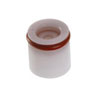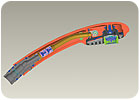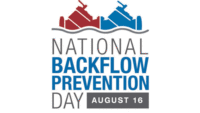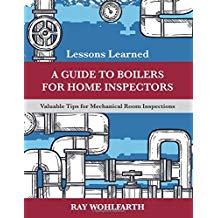It’s easy to take water for granted. Many consumers think there’s an endless supply of drinking water, and it’s available at their fingertips. Just turn on the faucet and, like magic, there it is!
Perhaps Samuel Taylor Coleridge had it right when he wrote The Rime of the Ancient Mariner in the late 1700s: “Water, water, everywhere, nor any drop to drink.” The fact is, around the globe, scientists are discovering our water supply may seem abundant, but our drinkable water supply is in high demand and short supply. That is why the plumbing industry has dedicated considerable efforts to protecting what drinkable water we have through devices and technologies that have evolved over the last century.


In static conditions, the spring tension forces the plunger into its seat, keeping the check valve closed.
Keeping Up With the Flow
Backflow and cross contamination are some of the most common risks to our water supply. Backflow prevention first drew attention in the late 1800s when a textile mill caught fire and river water was used to put it out. During this event, contamination of the supply water ensued, thus raising awareness of the need to protect our water supply. Contamination occurs through backflow when there’s a reversal of water flow direction. Water distribution systems are designed with the intention of water flowing in one direction-from the water supply to the consumer.
Under normal conditions, potable water is delivered from the supply when pressure upstream moves it up through the fixture and out of the spout. If the pressure downstream increases, or if the system pressure upstream decreases (known as backsiphonage), non-potable water can enter the drinking water supply and contaminate it.
As a result of the textile mill incident in the late 1800s, external check valves were introduced in order to protect the water supply. Initially, a single check valve was installed alongside the discharge outlet and used to prevent backflow, but they were proven unreliable, so a device with two checks was eventually developed in the early 1900s. However, even these valves were not foolproof.
The first valves were prone to fouling, due to foreign matter within the plumbing system or even buildup of mineral deposits. When tests were performed on backflow-prevention devices, these checks would be intentionally fouled with a 0.32 wire and a vacuum pulled on the system. In order to overcome the vacuum that was being allowed through the gap between the fouling wire and the check, there was a need to provide air inlets; otherwise the check would allow non-potable water to enter the potable water system if a backflow situation arose.
New technologies in the elastomer industry have produced materials that do not get fouled easily. In fact, a vacuum cannot be pulled on some fouled check valves today. In addition, check valves are being manufactured more reliably today. Still, backflow can occur, and it is vital that manufacturers rigorously test their devices to ensure the risk of backflow is minimal. With several prevention devices available now, the question many plumbing manufacturers may face is whether to install internal or external check valves.

When water flows, the pressure exceeds the spring tension and the plunger is lifted off its seat, allowing water through the valve.
What's On the Inside Counts
Conventional backflow prevention devices or assemblies require that there be an atmospheric vent in order to keep backsiphonage from occurring. For many installers and consumers, this creates a problem. At some point, atmospheric vents leak, which means they need to be installed where the leak is visible. Thus, these traditional devices are often an entirely separate component of the plumbing system. This adds expense to the installation, and discourages-to a significant extent-the device from being installed.
When a homeowner goes shopping for a new or replacement hand shower, or dislikes a leaky atmospheric vent, the likelihood of just eliminating the backflow protection is high. Since there is no inspection or enforcement in these cases, many times there is no way to ensure proper backflow prevention will occur. Where backflow prevention is important to protecting public health, it is essential that alternative, reliable means of providing backflow protection be made available to the public.
In 1996, the American Society of Mechanical Engineers (ASME) introduced the ANSI/ASME A112.18.3 standard for backflow prevention devices. This standard is applicable to plumbing fixture fittings with outlets not protected by an air gap, including fittings with hose-connected outlets, fittings with pull-out spouts, hand-held showers, shampoo fittings and deck-mounted fittings. The standard recognized “new concept” devices, such as internal check valves, as an alternate to the external devices.
Internal checks allow manufacturers an opportunity to add backflow-prevention devices to products like hand showers and kitchen pull-out spout wands without compromising the design that consumers want, and at a low enough manufacturing cost that they could easily become mandatory. These devices can be located in the wand of the fixture fitting and are designed to remain closed when the fixture is turned off and there is no water flow.

If pressure downstream increases or pressure upstream decreases, causing water flow to reverse, the spring-loaded plunger will close to prevent backflow.
A current design of this type of valve consists of three main parts: housing (the cylindrical casing of the device), the external seal (an o-ring seal that provides sealing between the check valve housing cartridge and the mating cavity into which it is inserted) and the closing system (a spring, plunger and internal seal).
When there is no water flow, the spring tension forces the plunger into its seat, keeping the valve sealed. When water flows, the pressure of the water pushes the plunger off its seat, allowing water through the valve. If the pressure downstream of the valve increases, or if the system pressure upstream of the valve decreases, causing the flow of water to reverse, the spring-loaded plunger closes to prevent non-potable water from passing back through the valve and into the water supply.
For example, Delta Faucet Co. now installs two of these devices, manufactured by NEOPERL, in every hand shower and every pull-out and pull-down faucet. This is a choice made by the manufacturer to comply with the standard.

Delta’s Signature Pull-Out faucet, pictured here in Matte Black finish, uses two internal check valves for proper backflow prevention.
Passing the Test
A backflow prevention valve is only useful if it works properly. Even the slightest leak has the potential to contaminate the drinking water supply, thus putting many people at risk. The criterion on which A112.18.3 was developed is that of reliability for those devices that fall under the “new concept” category, including internal check valves. Not only are these devices tested as individual devices, but they also must be tested within their plumbing fixture fitting to ensure this backflow protection is still maintained.
Along with the reliability concept, the standard recognizes that backflow protection can be obtained with a combination of devices, such as check valves, vacuum breakers, vents to air and automatic diverters. Criteria for compliance as a new category device requires that there be at least two of these backflow prevention devices in series, proved by tests in the standard. The devices shall operate independently as integral parts of the fixture fitting. At least one device shall be a check valve, called the primary check. The standard requires that contaminants are not allowed to enter the potable water system through backflow, nor shall contaminants be allowed to enter the fitting beyond the first barrier.
Manufacturers are required to specify the type and location of the backflow prevention system and describe the function of the devices in their product literature and installation instructions. Because this standard is based on the concept of reliability, a manufacturer also is required to submit a minimum of 36 samples, of which 34 will be used for stringent testing in two sets of 17, and two will be used for general inspection.
One set of 17 samples is subjected to the following test sequence: backpressure, backsiphonage, aging and corrosion, backpressure, backsiphonage and leakage.
The second set of 17 samples is subjected to a second test sequence: backpressure, backsiphonage, mechanical wear and mineral deposits, backpressure, backsiphonage and leakage.
Testing of devices that meet the new concept category of ANSI/ASME A112.18.3 has shown that they outperform devices that have traditionally been accepted in the plumbing system, when subjected to the 18.3 reliability/durability testing. These devices have proven they are capable of standing up to the toughest standards in the industry.

Click on larger image and notice the two small blue plungers located back-to-back in the wand of the faucet. These are the two internal check valves.
What It All Boils Down To
Technology has advanced, as has the reliability of most engineered products-including check valves. With recent innovations, the plumbing industry has the advantage of a wider selection of solutions when it comes to protecting the water supply. As the ANSI/ASME A112.18.3 standard testing procedures show, today’s internal check valves are built to stand up to the most stringent testing methods.
By using internal check valves, manufacturers are not only ensuring a more convenient installation process for the plumber and a more aesthetically pleasing sink or tub for the consumer, they also are accepting the role of leadership in the industry by promoting advanced products and protection of public health.
More importantly, as the liaison between the manufacturer and the consumer, plumbers and plumbing engineers play a vital role in the selection process and must also accept this role of leadership by selecting devices with internal check valves. By doing so, these plumbers and plumbing engineers are simplifying the installation process while offering their customers the best products on the market-and peace of mind. As professionals in the plumbing industry, water is our most valuable and precious resource. Let’s not take it for granted, but do all we can to keep it safe for drinking.
Sally Remedios is the manager of product compliance for Delta Faucet Co. and ensures that all plumbing products under the brands Delta, Peerless and Brizo meet all the national consensus standards, as well as the federal and state laws that apply.

